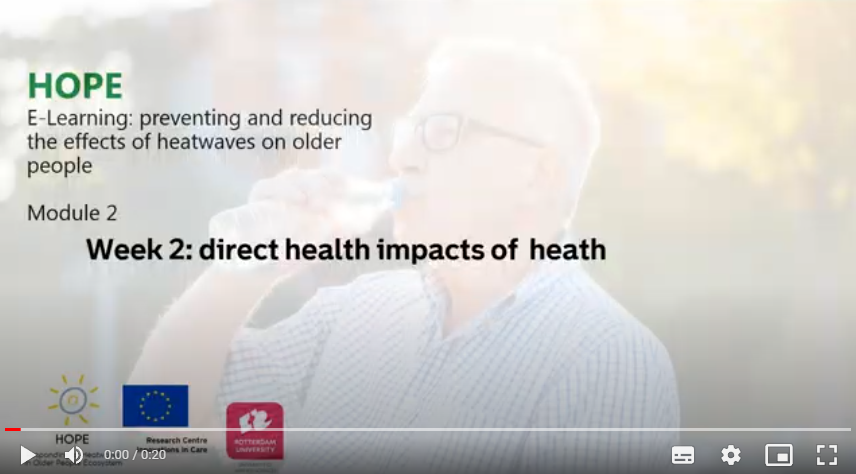HOPE E-COURSE for FORMAL CAREGIVERS -ENGLISH
Module 2 Week 2 Direct health impacts
 Goal: The student interprets the direct
health impacts of exposure to extreme heat.
Goal: The student interprets the direct
health impacts of exposure to extreme heat.
Welcome to
the second week of this module. We will focus on the direct health impacts of
exposure to extreme heat. On the right side of Figure 2.2, you will find the
direct impacts of exposure to extreme heat. As you can see, one can get ill from exposure to heat. But one can also die due to exposure to heat. And
lastly, hospitalization may be a result of exposure to heat. Reading the
articles of Watts, N. et all. (2020) and Lee et all. (2019) will help you to understand how heat and
health are connected. Figure 2.2 sums it nicely up.

The following animation video explains the different direct heat-related health consequences.
For (health) professionals it is essential to understand the effects of exposure to heat to prevent and mitigate the risks associated with hot weather.
In the following Presentation, the most important consequences are explained.
https://drive.google.com/file/d/1F0mw7OD-vvbtIe-YUpRm-ytGNyWgXpJO/view?usp=sharing
Some
significant direct health consequences of extreme heat include:
1. Heat Exhaustion and Heat Cramps. Prolonged exposure to high temperatures can lead to heat exhaustion and heat cramps. Heat exhaustion occurs when the body fails to regulate its temperature effectively. This can result in symptoms such as weakness, dizziness, headache, nausea, excessive sweating, and muscle cramps. It typically occurs due to heavy physical activity in hot environments or inadequate fluid intake.
2. Heat Stress and Heatstroke. Heat stress refers to the body's inability to dissipate heat effectively, leading to a rise in body temperature. Symptoms include rapid breathing, excessive sweating, fainting, and signs of dehydration. If heat stress is not addressed promptly, it can progress to heatstroke, a medical emergency characterized by a body temperature above 104°F (40°C), hot and dry skin, confusion, seizures, and even loss of consciousness. Heatstroke can be fatal if not treated immediately. Anyone can get heatstroke. But infants and the older people are at especially high risk because their bodies may not be able to regulate temperature effectively.
3. Aggravation of Chronic Conditions. Extreme heat can worsen pre-existing health conditions. Individuals with heart disease, respiratory conditions, high blood pressure, or diabetes are particularly vulnerable. High temperatures force the heart and lungs to work harder, potentially leading to complications such as heart attacks, strokes, respiratory distress, and elevated blood pressure. Hot weather can also cause increased water retention, placing additional strain on the cardiovascular system.
4. Skin Problems. Prolonged exposure to extreme heat and sun can cause various skin issues. The most common is sunburn, which occurs due to the skin's overexposure to ultraviolet (UV) radiation. Sunburn can be painful and increase the risk of skin cancer. Heat and humidity can also trigger sun allergies and exacerbate pre-existing skin conditions, such as eczema. Sometimes, excessive sweating can block sweat ducts, leading to conditions like heat rash or prickly heat.
5. Dehydration Issues. Hot temperatures accelerate fluid loss through sweat, potentially leading to dehydration. When the body loses more fluid than it can replenish, dehydration occurs. Mild dehydration may cause symptoms such as thirst, dry mouth, fatigue, and headache. Severe dehydration, however, can be life-threatening, causing symptoms like rapid heartbeat, rapid breathing, confusion, extreme thirst, lack of sweating, and even unconsciousness. Dehydration can also disrupt the body's electrolyte balance, leading to complications such as muscle cramps, kidney problems, and seizures.
To mitigate the direct health effects of extreme heat, it is crucial to take preventive measures. These include staying hydrated by drinking ample fluids, seeking cool and shaded areas, wearing lightweight and loose-fitting clothing, and avoiding prolonged exposure to the sun during peak heat hours. It is also essential to check on vulnerable individuals, such as the elderly, children, and those with chronic health conditions, ensuring they stay cool and hydrated.
knowledge check
You can check if you understand the reasons and the consequences of heat-related health problems, by trying to answer the following two questions:
1. What is the relation between heat stress and heat stroke?
(please insert h5p: module 2 2.1)
2. What is the difference between an active and passive heatstroke?
(please insert h5p: module 2 2.2)
Miltos can you put here foto 2.1?
Answer 1:
Heat stress is the overarching name of different types of heat-related diseases, when the body cannot get rid of excess heat. When this happens, the body's core temperature rises and the heart rate increases. As the body continues to store heat, the person begins to lose concentration and has difficulty focusing on a task, may become irritable or sick, and often loses the desire to drink. The next stage is most often fainting and even death if the person is not cooled down. Heatstroke is the most severe type of heat-related disease. It is a life-threatening condition that causes your body to overheat. It’s defined as a body temperature above 104 degrees Fahrenheit (40 degrees Celsius). Heatstroke, also called sunstroke, is the most severe form of hyperthermia, or heat-related illness. Heatstroke can lead to brain damage, organ failure or death. There are two types of heatstroke: Exertional heatstroke: This form of heatstroke is usually the result of physical overexertion in hot, humid conditions. It can develop in a few hours. Non-exertional heatstroke: this type can occur due to age or underlying health conditions. It tends to develop over several days
Answer 2:
Heat stroke results either from physical exertion (such as exercise or strenuous labour) or physiological inability to regulate body temperature, also called passive heat stroke. If not recognized early or treated correctly, either form of heat stroke can result in permanent physical and/or mental disability and even death.
 # References
# References- Section 1 of Watts, N. et all. (2020). The 2020 report of The Lancet Countdown on health and climate change: responding to converging crises. In The Lancet, VOL 397, ISSUE 10269 PP 129-190 January 09 2021. DOI:https://doi.org/10.1016/S0140-6736(20)32290-X
- Page 14-15 of Lee, V. et all. (2019). HEAT WAVES AND HUMAN HEALTH EMERGING EVIDENCE AND EXPERIENCE TO INFORM RISK MANAGEMENT IN A WARMING WORLD. Report for the United States Agency for International Development Adaptation Thought Leadership and Assessments (ATLAS). Washington DC: Chemonics International Inc. Template (climatelinks.org)
- https://www.who.int/news-room/fact-sheets/detail/climate-change-heat-and-health#Overview
- https://www.who.int/news-room/fact-sheets/detail/climate-change-and-health
- Chapter 6 of the WHO report Heat and Health in the WHO European Region: Updated Evidence for Effective Prevention (2021). https://www.who.int/europe/publications/i/item/9789289055406

